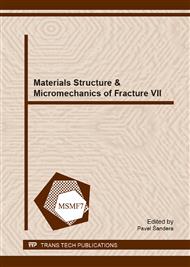p.51
p.55
p.61
p.67
p.71
p.75
p.79
p.83
p.87
Thermally Activated Dislocation Motion in an AS21 Alloy and Alloy Reinforced with Short Ceramic Fibres Studied at Elevated Temperatures
Abstract:
AS21 magnesium alloy (2.1Al-1Si-balance Mg in wt.%) and the alloy reinforced with short δ-Al2O3 fibres (Saffil®) were deformed in compression at temperatures between 23 and 300 °C. Stress relaxation tests were performed in order to reveal features of the thermally activated dislocation motion. Internal and effective components of the applied stress have been estimated. The activation volume decreases with increasing effective stress. The values of the activation volume and the activation enthalpy indicate that the main thermally activated process in the alloy as well as in the composite is the dislocation motion in non-compact planes.
Info:
Periodical:
Pages:
71-74
Citation:
Online since:
November 2013
Authors:
Keywords:
Price:
Сopyright:
© 2014 Trans Tech Publications Ltd. All Rights Reserved
Share:
Citation:


